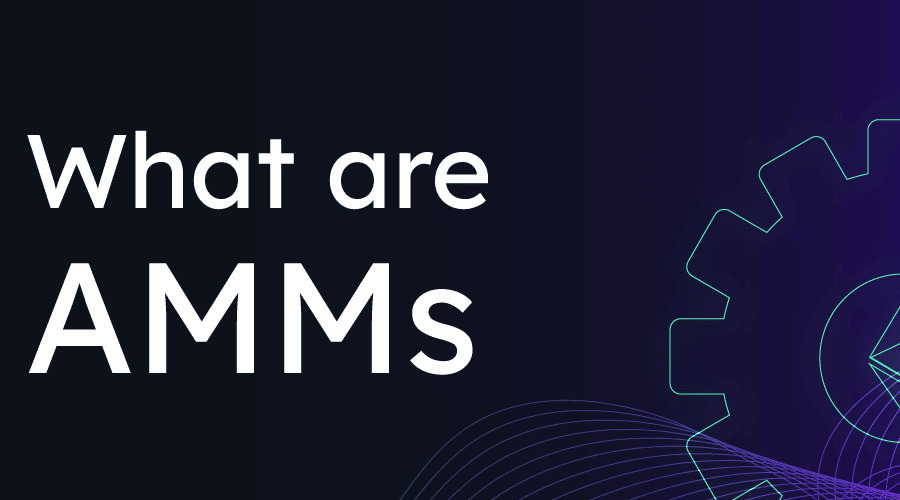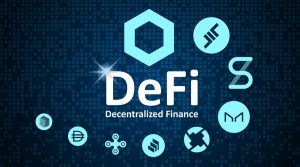Cryptocurrencies and decentralized finance (DeFi) have revolutionized the traditional financial landscape, introducing innovative concepts and technologies. One such concept is the Automated Market Maker (AMM), which has gained significant popularity in the DeFi space. In this article, we will delve into the world of AMMs, understand their working mechanisms, explore their types, discuss their benefits, and analyze the challenges they pose. Additionally, we will examine some popular AMMs in DeFi and explore their future prospects.
Introduction
The rise of blockchain technology and smart contracts has enabled the creation of decentralized exchanges (DEXs) that operate without intermediaries. AMMs, a key component of DEXs, are algorithmic protocols that facilitate decentralized trading by automatically creating and maintaining liquidity pools. Unlike traditional order books, which rely on buyers and sellers to determine prices, AMMs utilize mathematical formulas and supply-demand dynamics to provide liquidity and execute trades.
What are Automated Market Makers?
Automated Market Makers are smart contract protocols that allow users to trade cryptocurrencies directly from their wallets, eliminating the need for intermediaries. These protocols use liquidity pools, where users can deposit their assets and receive liquidity provider (LP) tokens in return. LP tokens represent a proportional share in the pool and enable users to participate in the protocol’s revenue and governance.
How do AMMs Work?
AMMs rely on mathematical formulas, typically utilizing the constant product formula known as the Automated Market Maker Formula (AMM Formula). The most widely used AMM Formula is the Constant Product Market Maker (CPMM) or the x*y=k formula. This formula ensures that the product of the token balances remains constant, allowing the protocol to determine the prices based on the relative supply and demand of the tokens.
When a user wants to trade on an AMM, they interact with the liquidity pool by swapping one token for another. This swap adjusts the token balances in the pool according to the AMM Formula, resulting in price changes based on the supply and demand dynamics. Traders pay a fee for each trade, which is distributed among the liquidity providers as an incentive for supplying liquidity to the pool.
Types of AMMs
There are several types of AMMs, each with its own unique characteristics and use cases. Some of the popular ones include:
- Constant Product AMMs: These AMMs, such as Uniswap and SushiSwap, utilize the CPMM formula and are widely used for trading ERC-20 tokens.
- Constant Mean AMMs: Examples include Balancer and Curve Finance, which allow for more complex token weighting and optimized liquidity provision.
- Stablecoin-focused AMMs: AMMs like Curve Finance specialize in trading stablecoins and aim to provide low-slippage trading for stablecoin pairs.
- Dynamic Pricing AMMs: Bancor is an example of a dynamic pricing AMM that adjusts token prices based on an algorithmic formula, reducing impermanent loss.
Benefits of AMMs
AMMs offer several benefits over traditional market makers and centralized exchanges. These include:
- Decentralization: AMMs operate on decentralized networks, eliminating the need for intermediaries and allowing for peer-to-peer trading.
- Liquidity Provision: AMMs enable anyone to become a liquidity provider by depositing their assets into the liquidity pools, earning passive income through trading fees.
- Continuous Availability: AMMs are available 24/7, allowing users to trade at any time without relying on market hours or order book depth.
- Transparency and Security: AMMs are built on blockchain technology, ensuring transparent and tamper-resistant transactions.
- Permissionless Access: Anyone with a compatible wallet can access and use AMMs, promoting financial inclusivity.
Challenges and Risks of AMMs
While AMMs have numerous advantages, they also face challenges and risks. These include:
- Impermanent Loss: Liquidity providers are exposed to impermanent loss when the relative prices of tokens in the pool change.
- Front-Running and Manipulation: AMMs can be susceptible to front-running and other manipulative practices due to their transparent nature.
- Limited Price Accuracy: AMMs may face challenges in accurately reflecting the market price, especially during periods of high volatility or low liquidity.
- Smart Contract Vulnerabilities: The security of AMMs relies on the robustness of the underlying smart contracts, which can be subject to vulnerabilities if not audited properly.
Popular AMMs in DeFi
DeFi has witnessed the rise of several popular AMMs that have gained significant traction within the community. Some of these include:

- Uniswap: Uniswap is one of the pioneering AMMs and remains a leading decentralized exchange with a user-friendly interface.
- SushiSwap: Forked from Uniswap, SushiSwap introduced additional features like yield farming and token incentives to attract liquidity providers.
- PancakeSwap: Built on the Binance Smart Chain, PancakeSwap offers a familiar AMM experience to users and has gained popularity due to its low transaction fees.
Examples of AMM Protocols
In addition to the popular AMMs mentioned above, there are various other protocols that showcase the versatility of AMM designs. These include:
- Balancer: Balancer allows for customizable liquidity pools with multiple tokens and different weightings, enabling diversified liquidity provision.
- Curve Finance: Curve Finance specializes in stablecoin trading and provides low-slippage swaps for stablecoin pairs.
- Bancor: Bancor employs dynamic pricing and utilizes an algorithmic formula to adjust token prices based on supply and demand.
AMMs vs. Traditional Market Makers
AMMs have disrupted the traditional market maker model by introducing decentralized and automated trading mechanisms. Unlike traditional market makers that rely on centralized intermediaries, AMMs operate in a trustless and permissionless manner. While traditional market makers can offer more personalized liquidity provision, AMMs excel in their accessibility, continuous availability, and transparency.
Future of AMMs in DeFi
The future of Automated Market Makers (AMMs) in the decentralized finance (DeFi) space looks incredibly promising. As blockchain technology and DeFi continue to advance, AMMs are set to play a pivotal role in shaping the future of finance. Here are some key aspects that highlight the bright future of AMMs in DeFi:
- Innovation and Improvement: AMMs have already undergone significant innovation since their inception. However, the journey doesn’t end here. As developers and researchers continue to explore new possibilities, we can expect further improvements in AMM designs, algorithms, and functionalities. This includes addressing current limitations, such as impermanent loss, and introducing advanced risk management strategies.
- Enhanced Price Accuracy: Price accuracy is crucial for efficient trading. While AMMs have been successful in providing liquidity, price slippage can still occur, especially during periods of high volatility or low liquidity. In the future, we can anticipate the development of sophisticated oracle systems and improved price discovery mechanisms that minimize price discrepancies and offer more accurate pricing on AMMs.
- Advanced Risk Mitigation: DeFi is known for its composability, allowing different protocols to interact seamlessly. However, this also introduces new risks. In the future, AMMs may adopt advanced risk management strategies to minimize the impact of potential smart contract vulnerabilities, flash loan attacks, and other security concerns. This could involve implementing more robust auditing processes and integrating insurance mechanisms to protect users’ funds.
- Scalability and Interoperability: As DeFi continues to gain traction, scalability becomes a crucial factor. Layer 2 solutions, such as sidechains and state channels, are being actively developed to address the scalability challenges faced by the Ethereum network. AMMs are likely to benefit from these solutions, enabling faster and cheaper transactions while maintaining the security and decentralization offered by the underlying blockchain technology. Furthermore, the rise of cross-chain interoperability protocols will allow AMMs to expand their reach beyond a single blockchain, unlocking a broader range of trading opportunities.
- Integration with Traditional Finance: The boundary between decentralized and traditional finance is gradually blurring. AMMs have the potential to bridge this gap further by integrating with traditional financial systems. This integration could involve partnerships with regulated institutions, compliance with regulatory frameworks, and the introduction of fiat on-ramps, making DeFi and AMMs more accessible to a wider audience.
Conclusion
Automated Market Makers (AMMs) have revolutionized decentralized trading in the DeFi ecosystem. By leveraging mathematical formulas and liquidity pools, AMMs offer users the ability to trade cryptocurrencies without intermediaries. While they bring numerous benefits, such as liquidity provision and continuous availability, AMMs also face challenges and risks. Nevertheless, with their popularity and the ongoing development of the DeFi space, AMMs are poised to play a significant role in the future of finance.
FAQs
Q1: Are AMMs only used for trading cryptocurrencies? AMMs are primarily used for trading cryptocurrencies, but they can potentially be applied to other asset classes as well. The underlying technology can be adapted to facilitate the exchange of various digital assets.
Q2: Can anyone become a liquidity provider in an AMM? Yes, anyone can become a liquidity provider in an AMM by depositing their assets into the liquidity pools. However, it’s important to understand the risks involved, such as impermanent loss and potential smart contract vulnerabilities.
Q3: How do AMMs ensure the security of transactions? AMMs are built on blockchain technology, which provides inherent security through its decentralized and tamper-resistant nature. Transactions on AMMs are recorded on the blockchain and are transparent and verifiable.
Q4: What is impermanent loss, and how does it affect liquidity providers? Impermanent loss refers to the temporary reduction in the value of liquidity provider assets due to price fluctuations of tokens in the liquidity pool. Liquidity providers may experience losses when the relative prices of tokens change during their participation in the pool.
Q5: How can I access and use AMMs? To access and use AMMs, you need a compatible cryptocurrency wallet that supports the specific AMM protocol. Once you have a wallet set up, you can connect it to the desired AMM platform and start trading or providing liquidity.






